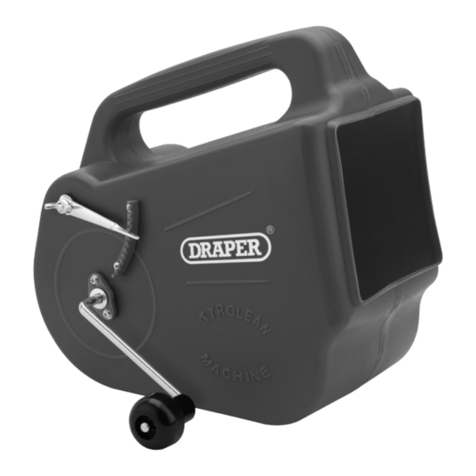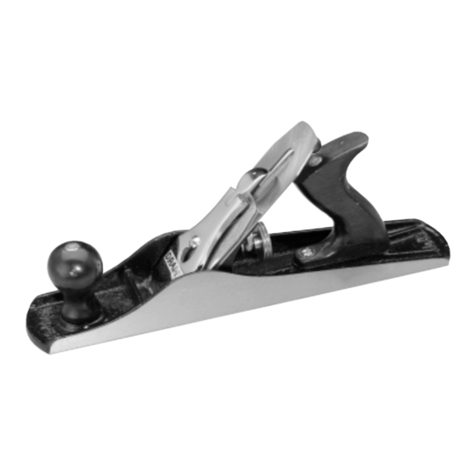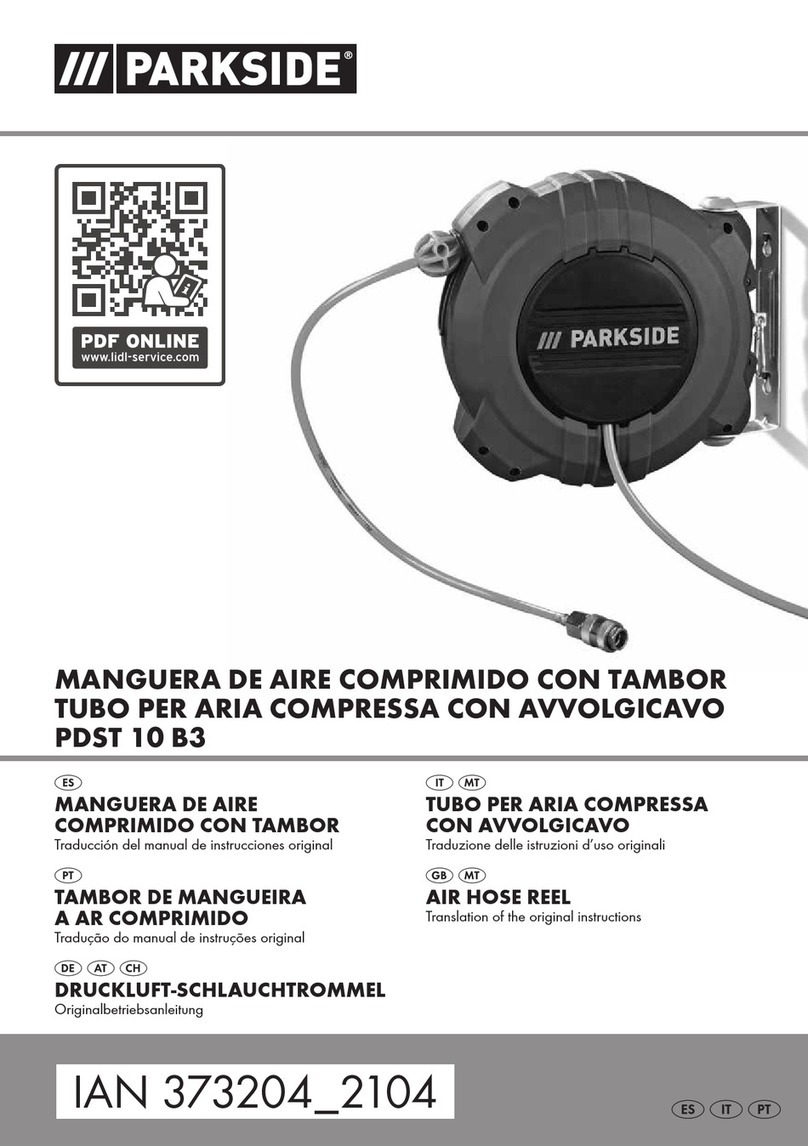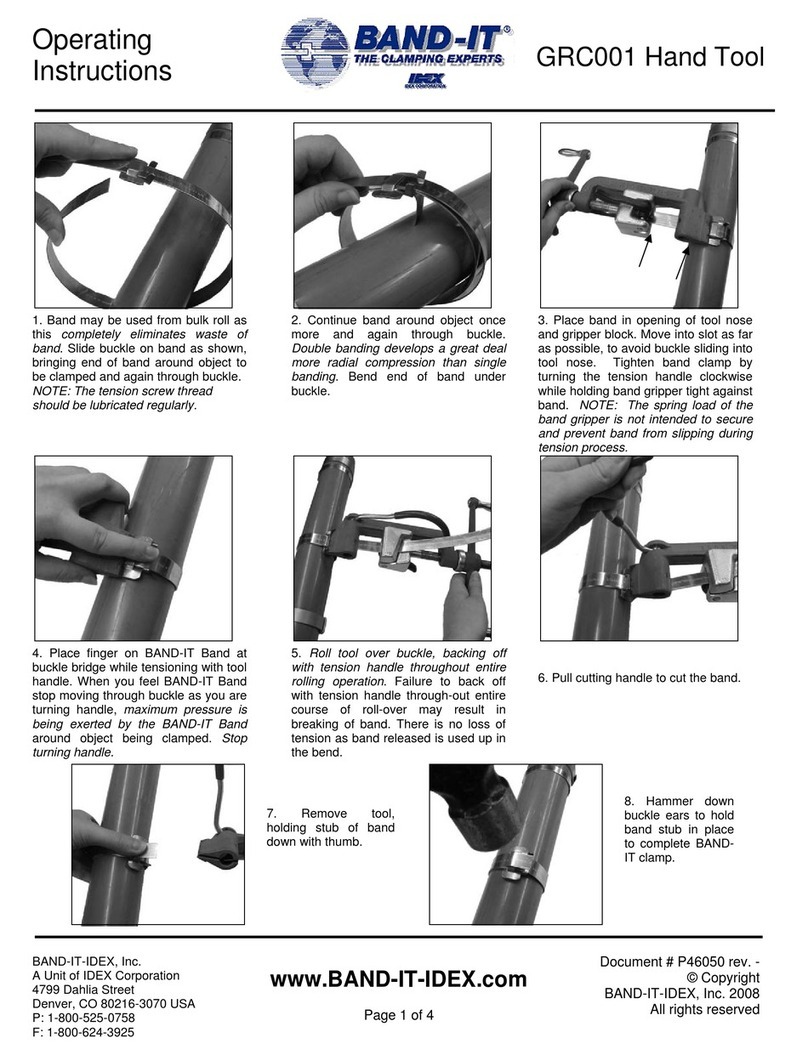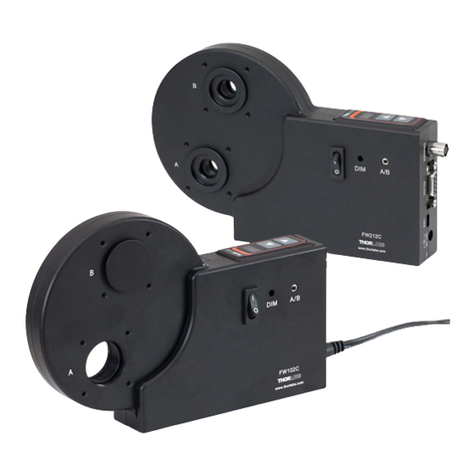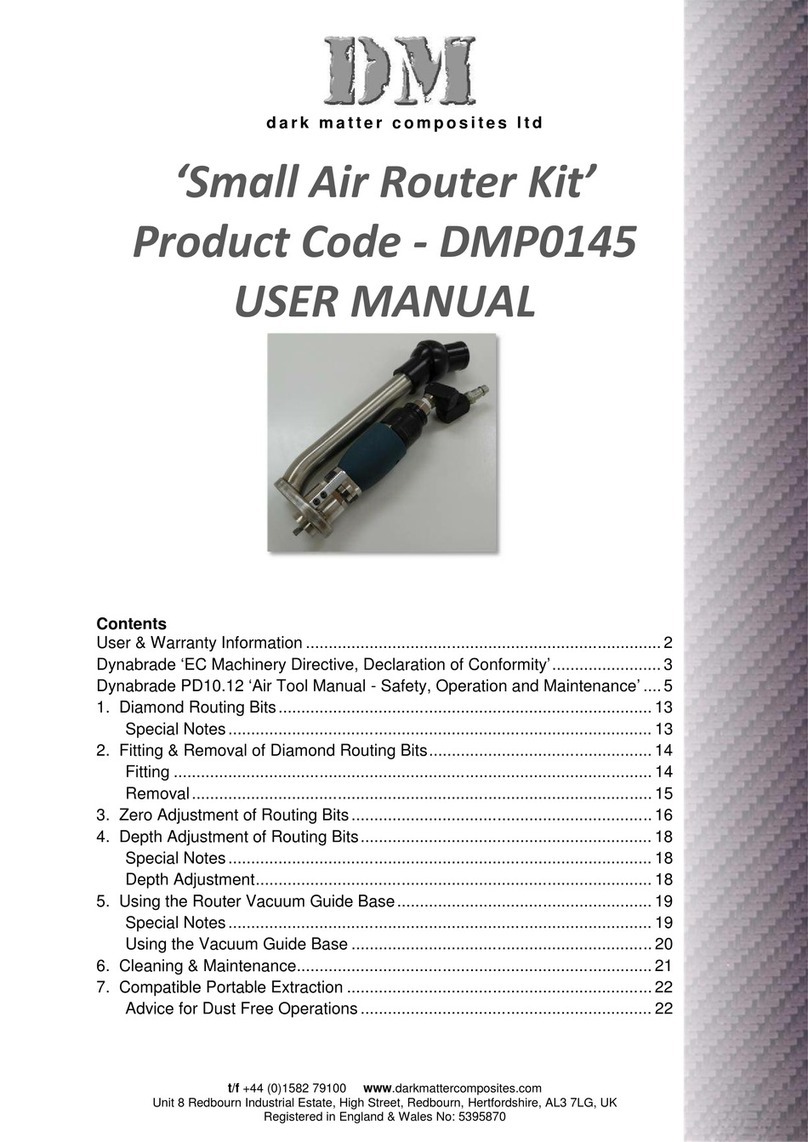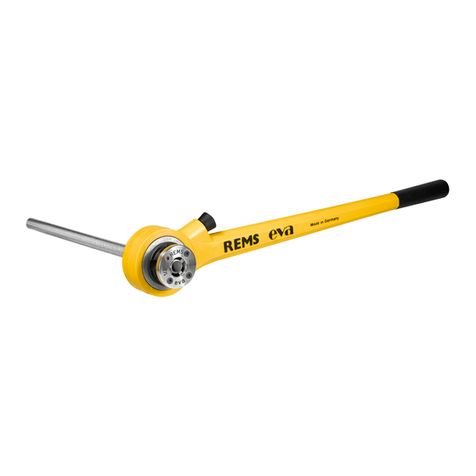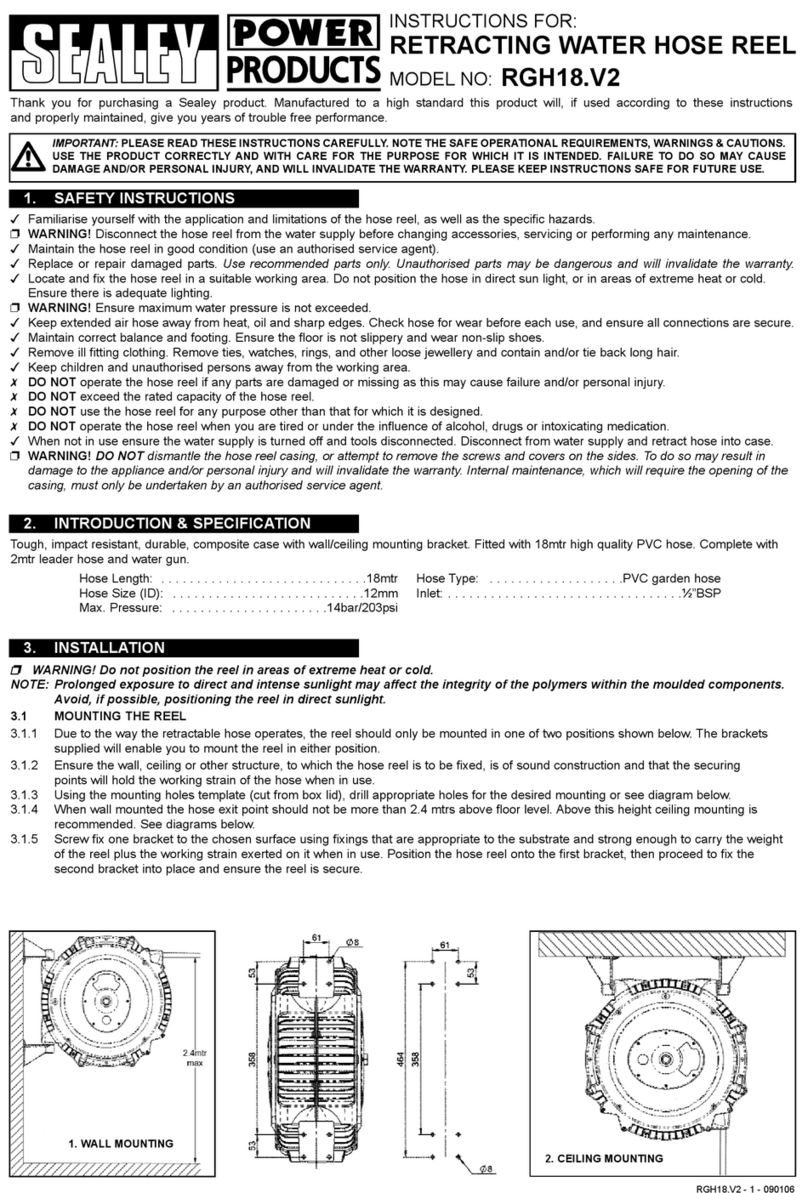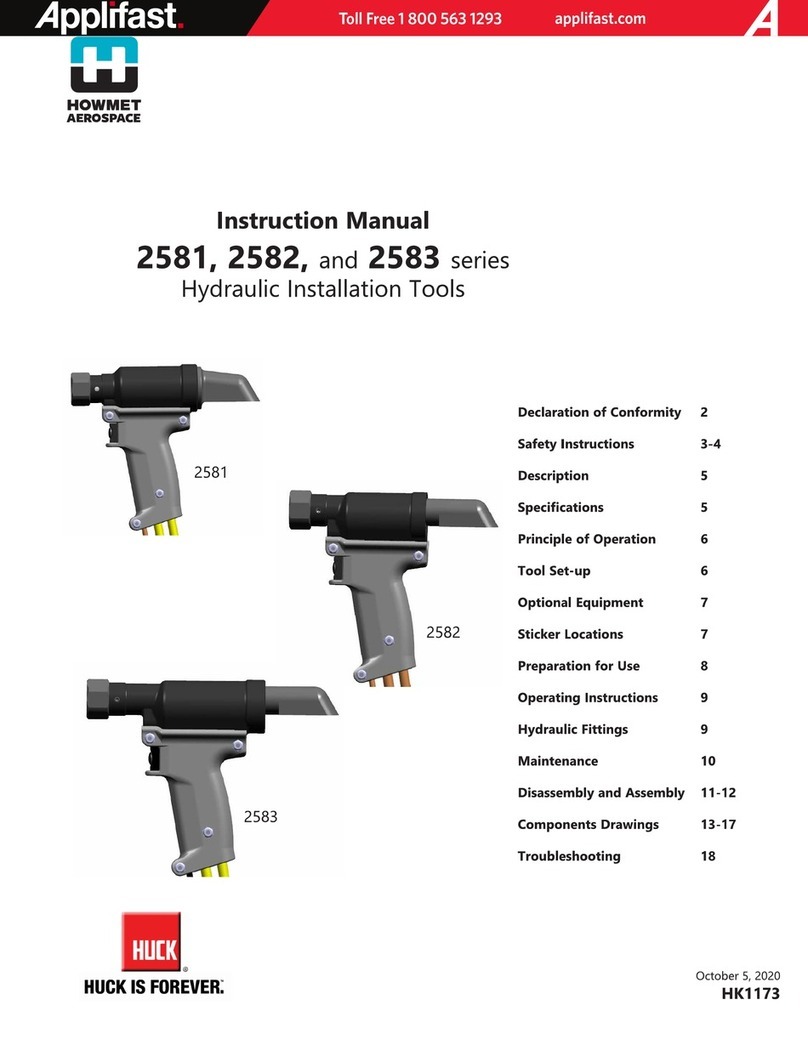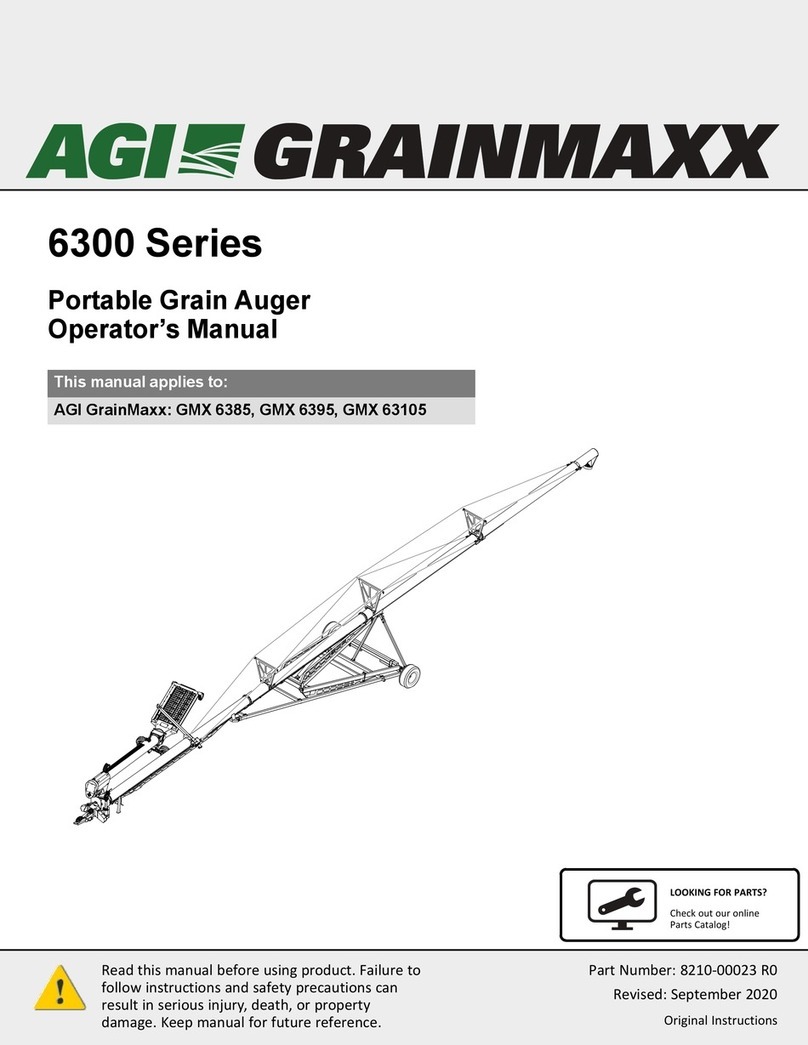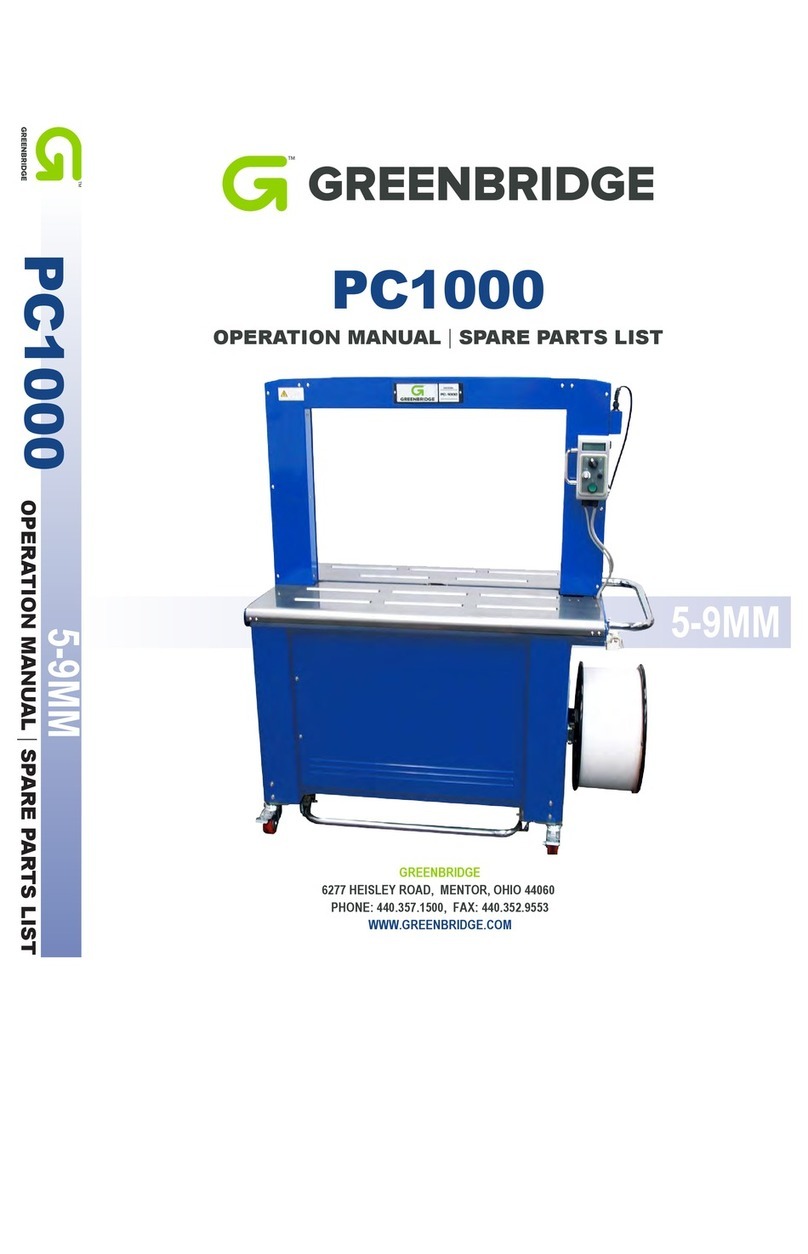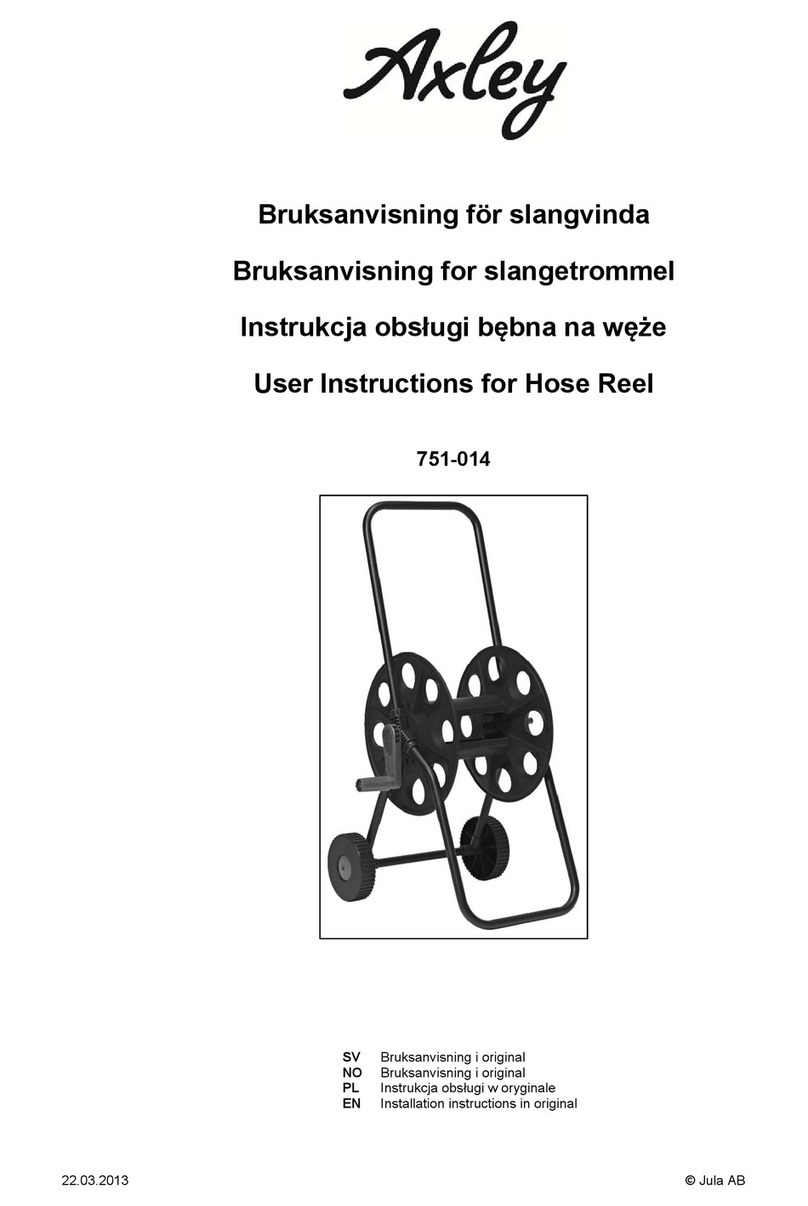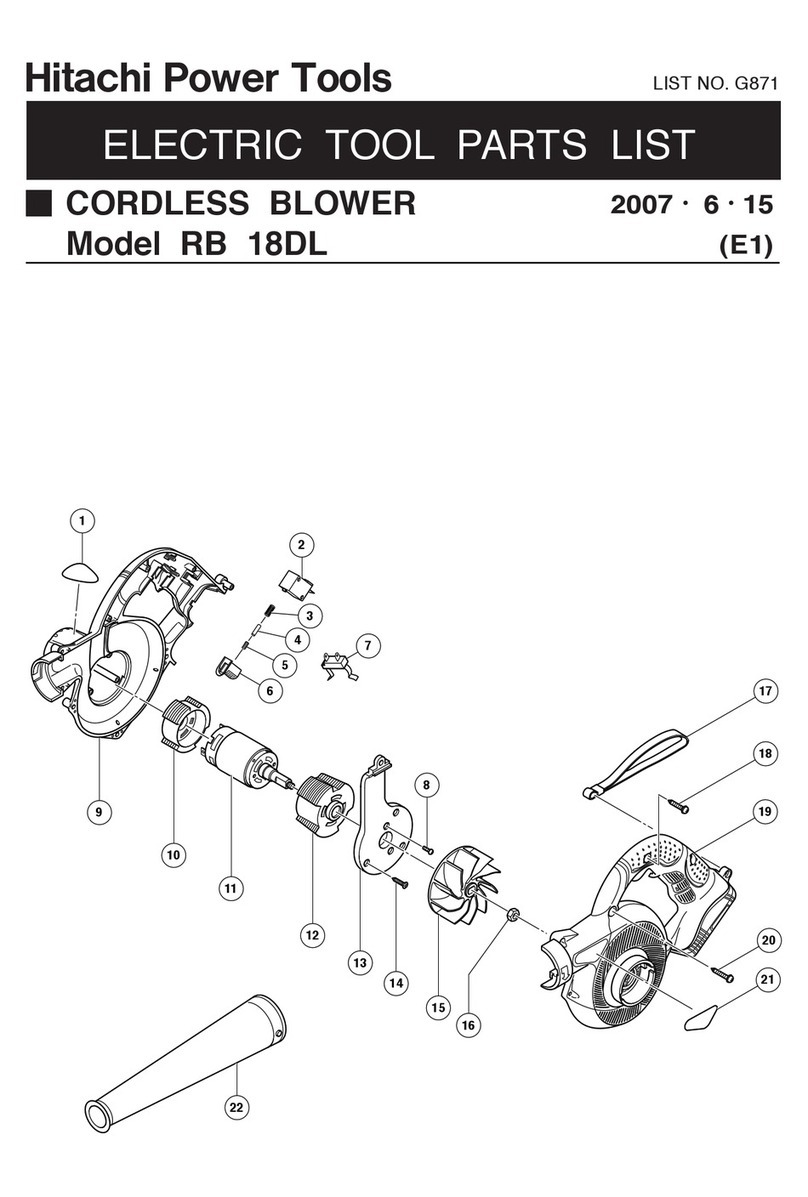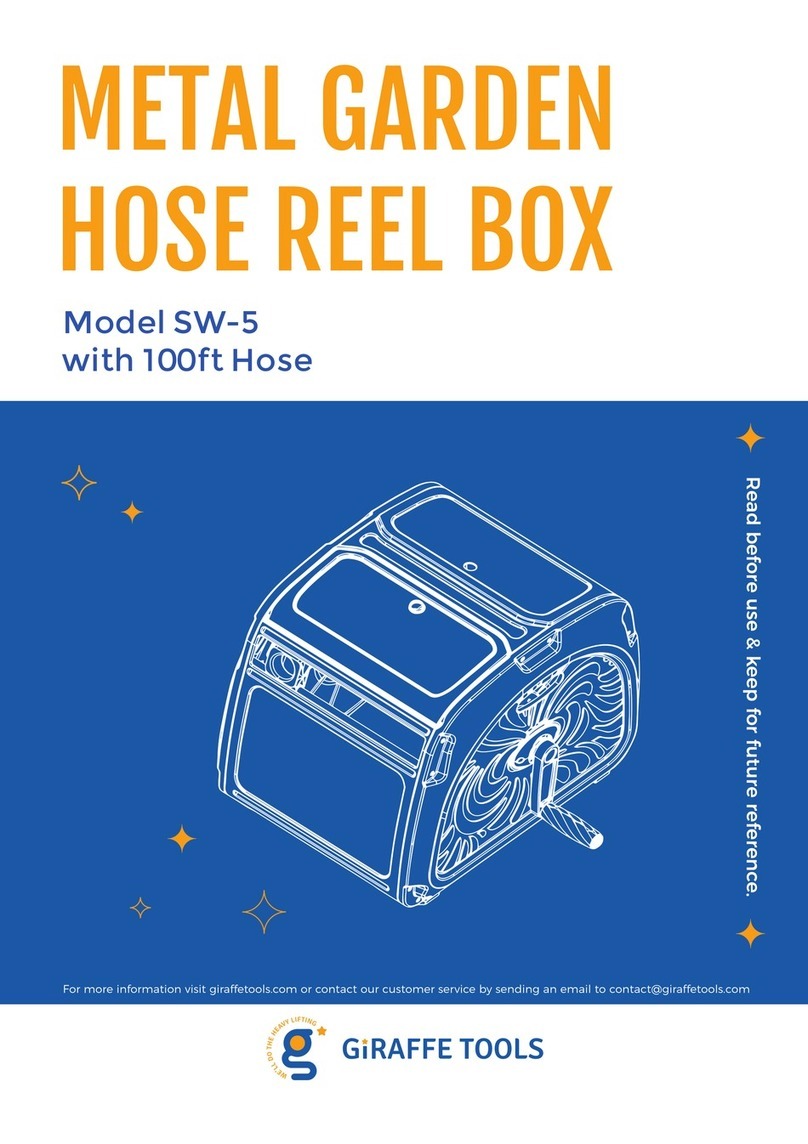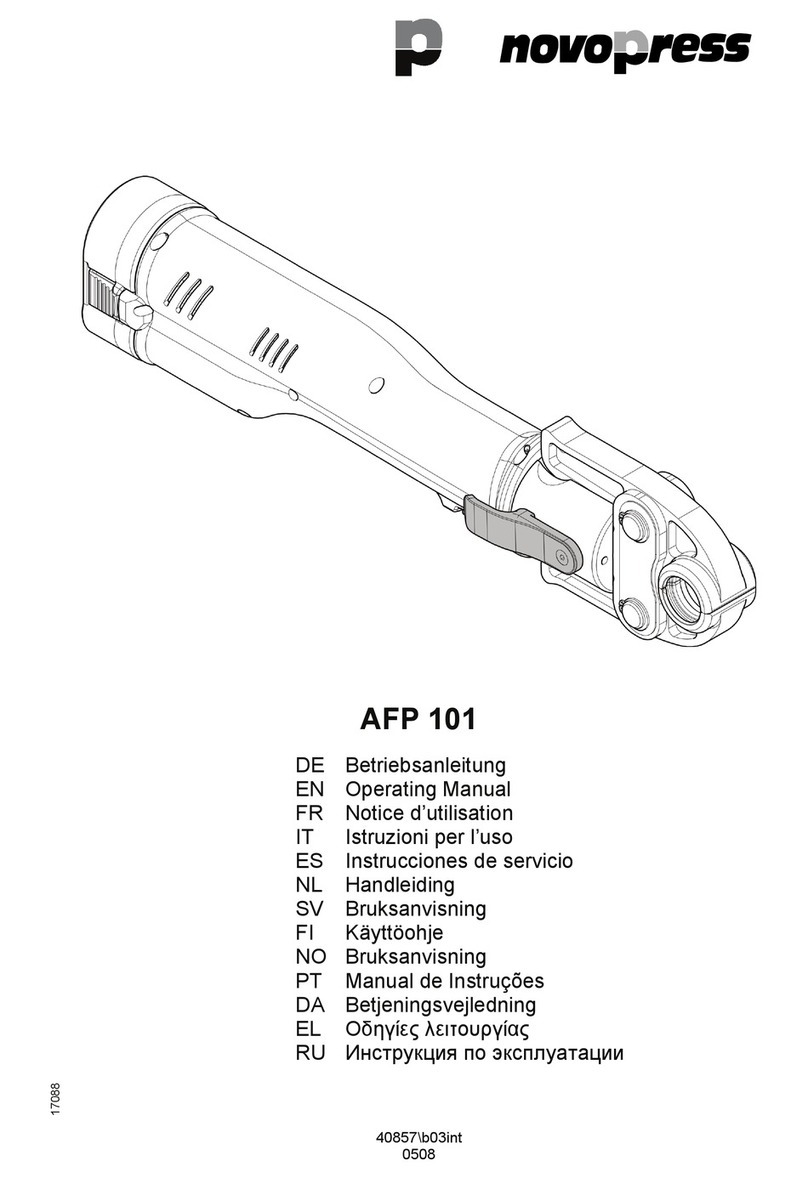Draper 28357 User manual

28357
EN
Original Instructions
Version 1
5 PIECE
AIR TOOL KIT

1. Preface
– 2 –
These are the original product instructions. This
document is part of the product; retain it for the life
of the product, passing it on to subsequent holders.
Read this manual in full before attempting to
assemble, operate, or maintain this product.
This Draper Tools manual describes the purpose
of the product and contains all the necessary
information to ensure its correct and safe use.
Following all the instructions and guidance in
this manual will ensure the safety of both the
product and the operator and increase the
lifespan of the product.
All photographs and drawings within this manual are
supplied by Draper Tools to help illustrate correct
operation of the product.
Every eort has been made to ensure the
information contained in this manual is accurate.
However, Draper Tools reserves the right to amend
this document without prior warning. Always use the
latest version of the product manual.
1.1 Product Reference
User Manual for: 5 Piece Air Tool Kit
Stock No: 28357
Part No: DAT-ATK5
1.2 Revisions
Version 1: June 2022
First release
As our manuals are continually updated, always ensure
that the latest version is used.
Download the latest version from:
drapertools.com/manuals
1.3 Understanding the Safety Content
WARNING! – Situations or actions that may result
in personal injury or death.
CAUTION! – Situations or actions that may result
in damage to the product or surroundings.
Important – Information or instructions of particular
importance.
1.4 Copyright © Notice
Copyright © Draper Tools Limited.
Permission is granted to reproduce this manual for
personal and educational use ONLY. Commercial
copying, redistribution, hiring, or lending is strictly
prohibited.
No part of this manual may be stored in a retrieval system
or transmitted in any other form or means without written
permission from Draper Tools Limited.
In all cases, this copyright notice must remain intact.

2. Contents
– 3 –
EN
1. Preface 2
1.1 Product Reference 2
1.2 Revisions 2
1.3 Understanding the Safety Content 2
1.4 Copyright © Notice 2
2. Contents 3
3. Warranty 4
4. Product Introduction 5
4.1 Scope 5
4.2 Specication 5
5. Health and Safety Information 6
5.1 General Health and Safety Precautions 6
5.2 Additional Safety Instructions for Air Tools 6
6. Identication and Unpacking 8
6.1 Product Overview 8
6.2 What’s in the Box? 10
6.3 Packaging 10
7. Preparation Instructions 11
7.1 Preparing the Air Supply for Use with All
Tools 11
7.2 Cleaning the Paint Spray Gun Before First
Use 12
7.3 Cleaning the Cleaning Gun, Air Gun and
Tyre Inator Before First Use 12
7.4 Assembly, Filling and Connection to the
Air Supply 12
8. Operating Instructions: Paint Spray Gun 14
8.1 The Fluid Control Dial 14
8.2 The Spray Control Dial 14
8.3 The Air Cap 14
8.4 The Trigger 15
8.5 Notes on Use 15
9. Operating Instructions: Cleaning Gun 16
9.1 The Nozzle 16
9.2 The Trigger 16
9.3 After Use 16
10. Operating Instructions: Air Gun and
Tyre Inator 17
10.1 Air Gun 17
10.2 Tyre Inator 17
11. Maintenance and Troubleshooting 19
11.1 General Maintenance 19
11.2 Cleaning the Paint Spray Gun 19
11.3 Cleaning the Cleaning Gun 20
11.4 Cleaning the Air Gun and Tyre Inator 20
11.5 Storing the Tools 20
11.6 Troubleshooting 21
12. Returns and Disposal 24
13. Explanation of Symbols 25

3. Warranty
Draper Tools products are carefully tested and inspected
before shipment and are guaranteed to be free from
defective materials and workmanship.
Should the tool develop a fault, return the complete tool
to your nearest distributor or contact Draper Tools
directly. Contact information can be found at the back of
this manual.
Proof of purchase must be provided.
If, upon inspection, it is found that the fault occurring is
due to defective materials or workmanship, repairs will
be carried out free of charge.
This warranty period covers
parts and labour for six months from the date of purchase.
Where tools have been hired out, the warranty period
covers 90 days from the date of purchase.
This warranty does not apply to any consumable parts,
batteries or normal wear and tear, nor does it cover any
damage caused by misuse, careless or unsafe handling,
alterations, accidents, or repairs attempted or made by
any personnel other than the authorised Draper Tools
repair agent.
In all cases, to make a claim for faulty workmanship or
materials within the standard warranty period, please
contact or return the product to the place of purchase.
Proof of purchase may be required.
If the place of purchase is no longer trading or if you
experience any diculties with your warranty, please
contact Customer Services with the product details and
your proof of purchase. Contact details can be found at
the back of this manual.
If the tool is not covered by the terms of this warranty,
repairs and carriage charges will be quoted and charged
accordingly.
This warranty supersedes any other guarantees
expressed or implied and variations of its terms are not
authorised.
Your Draper Tools guarantee is not eective until you can
produce, upon request, a dated receipt or invoice to
verify your purchase within the guarantee period.
Please note that this warranty is an additional benet
and does not aect your statutory rights.
Draper Tools Limited
– 4 –

4. Product Introduction
– 5 –
EN
4.1 Scope
This product contains four air tools and an air hose and is
designed for use with receiver compressors.
The gravity-fed paint spray gun is suitable for use with all
types of paint, including water-based paints, for
light-viscosity painting applications.
The cleaning gun is suitable for use with degreasing and
cleaning agents and detergents, and is intended for
removing dirt, grease and oil from engines and
machinery.
The air gun is intended for cleaning with compressed air
and clearing blockages from small spaces.
The tyre inator is intended for inating tyres. Always
double-check tyre pressure against a BS 4613-compliant
tyre pressure gauge after use.
The air hose is intended for the connection and
extension of 1/4" air lines.
Part of our core range, this product is suitable for regular
use by enthusiasts and tradespersons alike.
WARNING! This product is not a toy and must
be respected.
Read this manual in full before attempting to assemble,
operate or maintain the product, and retain it for later use.
4.2 Specication
Stock No. 28357
Part No. DAT-ATK5
Paint spray gun:
Nozzle 1.5mm
Cup capacity 500ml
Operating air pressure 3–4bar (43–58psi)
Max. air pressure 4.5bar (65psi)
Air inlet 1/4" BSP
Net weight 0.415kg
Operating air pressure 0–8bar (0–116psi)
Max. air pressure 9bar (130psi)
Air inlet 1/4" BSP
Gauge diameter 64mm
Scale colour (bar) Black
Scale colour (psi) Red
Hose inlet 1/4” BSP
Hose length 0.36m
Net weight 0.279kg
Cleaning gun:
Nozzle 3mm
Cup capacity 900ml
Operating air pressure 4–8bar (58–116psi)
Max. air pressure 9bar (130psi)
Air inlet 1/4" BSP
Net weight 0.408kg
Air gun:
Max. air pressure 8.0bar (116psi)
Air inlet 1/4" BSP
Net weight 0.123kg
Air hose:
Inner diameter 5mm
Outer diameter 8mm
Length 5m
Max. air pressure 8bar (116psi)
Net weight 0.216kg
Kit net weight 1.68kg

5. Health and Safety Information
– 6 –
EN
Important: Read all Health and Safety instructions
before attempting to operate, maintain or repair this
product. Non-compliance with these instructions may
result in injury or damage to the user or the product.
5.1 General Health and Safety
Precautions
• Only authorised personnel who have carefully read
and understood this manual may operate, adjust and
repair this product.
• Observe all standard safety precautions and good
practices when working with air tools.
• Always wear adequate eye protection and a face mask
when using this product.
− Some products suitable for use with this product
may contain chemicals or toxic components.
− Avoid inhalation or contact with materials used
with this product.
− If contact occurs, seek medical advice as soon as
possible.
• Wear ear defenders and protective gloves while using
and cleaning this product.
• Keep your work environment clear and well-lit, with
bystanders at a safe distance.
• Use this product ONLY in well-ventilated areas to
avoid the build-up of fumes and allow paint particles
to disperse.
• Keep out of reach of children.
• Before every use, inspect the tools for missing,
broken, loose or corroded parts.
Important: DO NOT use this product if it is damaged
in any way. Contact Draper Tools to discuss repair and
replacement options.
• Ensure that all accessories and attachments are
securely tightened before use.
• Use the product only in the manner instructed in this
manual.
• DO NOT modify this product in any way.
• ONLY use spare parts supplied by Draper Tools.
• Stay alert at all times; DO NOT use this product while
tired or under the inuence of alcohol, drugs or other
medication.
• NEVER insert foreign objects into the nozzles of these
tools unless cleaning them with a soft brush.
5.2 Additional Safety Instructions for Air
Tools
• Compressed air can cause severe injury.
− ALWAYS turn o and disconnect the air supply
before making any adjustments to the product or
leaving it unattended.
− NEVER direct this product towards yourself or
others.
− NEVER direct compressed air jets towards objects
that contain combustible or hazardous
substances.
− Protect live components from dust and debris
blown by compressed air.
− Ensure that compressed air is not blocked by or in
contact with any part of your body.
• ONLY use clean, dry and regulated compressed air.
WARNING! NEVER use oxygen, combustible
gases or other bottled gasses as a supply for
this product. Use of these substances may
cause the product to explode.
• Use of a whip hose between the tools and the air
supply is recommended to reduce vibration.
CAUTION! Whipping hoses can cause severe
injury. Always check for and replace
• Ensure that the product is compatible with the air
supply before use.
• Ensure all connections are securely tightened.
• DO NOT exceed the maximum stated air pressure for
each tool.
− The pressure of the connected air supply MUST
NOT exceed more than 10% of the rated pressure
of the product.
• DO NOT obstruct the ability of the trigger to release
once depressed.
• NEVER cover the tool nozzle while the trigger is
depressed.
• NEVER carry the tool by the hose.
• Some parts of the tools may become hot during use.
− Allow the nozzles and cups to cool after use before
handling or adjusting them.
• NEVER spray ammable substances near open ames
or sources of heat and ignition.
− DO NOT smoke in the vicinity of this product.

5. Health and Safety Information
– 7 –
EN
• NEVER spray solvents, solvent-based liquids, acetone
or undiluted acids using the cleaning gun.
− Spray mist from these substances is very
dangerous and may be explosive.
• ONLY use biodegradable sprays with the cleaning gun
and clean the tool immediately after use.
WARNING! Blowing out of blind or narrow openings
may cause excessive noise. ALWAYS ensure
appropriate ear protection is worn during use.
• ALWAYS double-check tyre pressure against a
BS 4613-compliant tyre pressure gauge after
ination.
• DO NOT use these tools in temperatures that do not
fall within 0–40°C.
WARNING! The use of solvents that contain
halogenated hydrocarbons in pressurised
systems with aluminium or galvanised parts may
cause chemical reactions that result in an
explosion. This product contains components
halogenated hydrocarbons.
DO NOT use halogenated hydrocarbons with
this product. Many halogenated hydrocarbons

6. Identication and Unpacking
6.1 Product Overview
– 8 –
EN
Paint spray gun
(1) Air cap
(2) Air cap locking ring
(3) Fluid control dial
(4) Fluid needle
(5) Hanging loop
(6) Nozzle
(7) Spray control dial
(8) Spray direction control
(9) Spray gun air line inlet
(10) Spray gun paint cup
(11) Spray gun trigger
Air gun
(18) Air gun air line inlet
(19) Air nozzle
(20) Air gun trigger
(2)
(7)
(6)
(11)
(1)
(3)
(5)
(9)
(10)
(18)
(20)
(19)
(8)
(4)

6. Identication and Unpacking
– 9 –
EN
(21) Exhaust button
(22) Inator air line inlet
(23) Inator hose
(24) Inator trigger
(25) Pressure gauge
(26) Valve coupling
(27) Valve coupling catch
Cleaning gun
(12) Cleaning gun air line inlet
(13) Cleaning gun suction cup
(14) Cleaning gun trigger
(15) Hanging loop
(16) Nozzle
(17) Nozzle locking nut
(12)
(15)
(13)
(16)
(14)
(17)
(22)
(27)
(26)
(24)
(23)
(25)
(21)

6. Identication and Unpacking
Please visit drapertools.com for our full range of accessories and consumables.
– 10 –
EN
6.2 What’s in the Box?
Carefully remove the product from the packaging and
examine it for any signs of damage that may have
occurred during shipment.
Before assembling the product, lay the contents out and
check them against the parts shown below. If any part is
damaged or missing, do not attempt to use the product.
Please contact the Draper Helpline; contact details can
be found at the back of this manual.
6.3 Packaging
Keep the product packaging for the duration of the
warranty period for reference should the product need to
be returned for repair. WARNING! Keep packaging materials out of
reach of children. Dispose of packaging
correctly and responsibly and in accordance
with local regulations.
(A) 1 x Paint spray gun
(B) 1 x Cleaning gun
(C) 1 x Air gun
(D) 1 x Tyre inator
(E) 1 x 5m air hose (5mm inner Ø)
(F) 1 x Paint cup
(G) 1 x Suction cup
(H) 1 x Tyre inator hose
(I) 1 x 1/4" BSP air line coupling
(A)
(F)
(I)
(B)
(G)
(D)
(C)
(H)
(E)

– 11 –
EN
Important: Before using this product, read and
understand all the safety instructions listed in this
manual.
7.1 Preparing the Air Supply for Use with
All Tools
The maximum operating pressure of these air tools is:
• Paint spray gun: 3.5bar (50psi)
• Cleaning gun: 8.0bar (115psi)
• Air gun: 8.0bar (115psi)
• 8.0bar (115psi)
The compressed air system must be controlled by a
combination pressure regulator and moisture lter; this
will ensure a constant supply of dry air at all times,
provided it is properly maintained.
Important: Always check the machine operating
pressure before use.
Water in the compressor tank may cause considerable
corrosion to air tools; the compressor should be drained
daily to avoid excessive water in the air supply. Dirty or
wet air can signicantly shorten the lifespan of the
product.
When using an air tool with a hose over 25ft long,
increasing the bore of the hose to the next largest
available size is recommended (i.e. increase 3/8" to 1/2").
This will ensure adequate pressure and volume of air to
power the tool.
Important: The tyre inator ONLY should be used with a
lubricator also installed in the air line.
CAUTION! DO NOT lubricate the air line when
using the paint spray gun, cleaning gun, or air
gun. For these tools, ensure that any oil device
has been removed and any residual oil purged
from the system before connecting the spray
gun.
7. Preparation Instructions
1 Fig.
Do not install quick
coupling here
To your
air tool
Nipple Nipple
Oiler
Whip hose Regulator* Air supply
Drain dailyAir line hose
Quick coupler Water separation

– 12 –
EN
2 Fig.
7. Preparation Instructions
7.2 Cleaning the Paint Spray Gun Before
First Use
Before rst use, the paint spray gun must be cleaned
thoroughly to remove any oil, grease and the protective
lm applied before shipment.
1. Disassemble the tool and immerse all parts in spray
gun cleaning uid.
2. Soak the parts for a few minutes.
3. Allow the parts to dry and then wipe them clean with
a damp cloth.
4. Assemble the tool (see 7.4) and half-ll the spray gun
paint cup (10) with thinners.
5. Squeeze the trigger to ush the thinners through the
tool until the paint cup is empty.
6. Immerse and soak the assembled tool in the cleaning
uid for a few more minutes.
7. Allow the parts to dry and wipe them clean.
7.3 Cleaning the Cleaning Gun, Air Gun
and Tyre Inator Before First Use
Before rst use, clean the cleaning gun, air gun and tyre
inator inside and out using compressed air. When
connected to the air line, blast a few jets of compressed
air through the tools before operation.
7.4 Assembly, Filling and Connection to
the Air Supply
Important: It is recommended to use a 1/4" BSP thread
whip hose (Stock No. 54438) to connect the spray gun to
an air line in order to reduce vibration.
1. Attach the appropriate cup to the correct thread on
the tool body (Fig. 2):
a. When using the spray paint gun (A), attach the
paint cup (F) to the uppermost thread on the tool
body.
b. When using the cleaning gun (B), attach the
suction cup (G) to the downward thread at the top
of the tool body.
c. Neither the air gun nor the tyre inator requires a
cup attachment.
(F)
(A)

– 13 –
EN
7. Preparation Instructions
5 Fig.
4 Fig.
2. If assembling the paint spray gun, rotate the uid
control dial (3) clockwise as far as possible to close
the uid valve (Fig. 3).
3. Wrap a length of PTFE tape around the tool air line
inlet (9) (12) (18) (22) (Fig. 4).
Important: For a more secure seal, the PTFE tape
should be wrapped in the opposite direction to the
thread.
4. Screw the 1/4" air line coupler (I) onto the spray gun
air inlet (Fig. 5).
If using a whip hose, attach a parallel union nut
(Stock No. 25823) instead of the air line coupling.
5. Connect the air line to the air line coupling.
If using a whip hose, wrap a length of PTFE tape
around the whip hose inlet and attach it to the air line.
6. If attached, unscrew the cup lid and pour in the
required quantity of uid.
Important: ALWAYS ensure that any paint is
mixed and thinned and cleaning substances are
diluted or treated according to the manufacturer’s
recommendations. ONLY use biodegradable sprays
with the cleaning gun.
7. Pressurise the air line when you are ready to begin.
8. If using the air gun or tyre inator ONLY, blast a few
jets of the compressed air line through the tool to
clear it of any residual debris.
3 Fig.
(3) (I)

– 14 –
EN
8 Fig.
7 Fig.
6 Fig.
8. Operating Instructions: Paint Spray Gun
Important: Before using this product, read and
understand all the safety instructions listed in this
manual. DO NOT make any adjustments to the paint
spray gun while the trigger is depressed.
8.1 The Fluid Control Dial
The uid control dial (3) adjusts the amount of paint that
is released into the airow and the density of the spray
when the trigger is fully depressed (Fig. 6):
• To increase the paint quantity and density:
Rotate the nozzle regulator anticlockwise.
− The paint quantity should be increased when the
spray gun is positioned further from the surface or
when the paint mixture has a higher viscosity.
• To decrease the paint quantity and density:
Rotate the nozzle regulator clockwise.
− The paint quantity should be decreased when the
spray gun is positioned closer to the surface or
when the paint mixture has a lower viscosity.
8.2 The Spray Control Dial
The spray control dial (7) adjusts the shape of the paint
jet released from the nozzle. The spray control dial can be
rotated more than 360° (Fig. 7).
• Rotate the dial clockwise.
• Narrower, rounder pattern: Rotate the dial
anticlockwise.
8.3 The Air Cap
The air cap (1) has three types of opening that aect the
pattern of the uid spray (Fig. 8):
• A hole for the nozzle head from which the uid is
dispersed (28).
• Atomising air holes (29) that break the uid into a
ne spray.
• Air horn holes (30) that shape the spray pattern
as required.
(3)
(7)
(29)
(30)
(28)

– 15 –
EN
10 Fig.
9 Fig.
8. Operating Instructions: Paint Spray Gun
Once the spray pattern has been set using the control
dial, rotate the air cap to change the orientation of
the jet.
Important: ALWAYS ensure that the air cap remains
tightly secured after adjusting its orientation.
8.4 The Trigger
Paint is released from the spray gun by squeezing the
spray gun trigger (11) (Fig. 9):
1. First, squeeze the trigger until resistance is met; this
opens the air valve.
2. Squeeze the trigger the rest of the way to draw the
uid pin back and release paint from the nozzle.
3. Important: Draper Tools recommends that you test
the spray output on an area of scrap material before
working on the actual surface. Adjust the control
dials to produce an even ow in the desired pattern.
ALWAYS release the trigger before making any
adjustment to the spray gun.
8.5 Notes on Use
• Keep the spray gun 6–8" away from the surface during
operation.
• Start moving the spray gun BEFORE squeezing the
trigger to prevent a build-up of paint at the starting
point.
• Move the spray gun with a smooth motion, keeping it
perpendicular to and at a constant distance from the
surface at all times (Fig. 10).
• DO NOT rock or pivot the spray gun as this will deliver
uneven coverage of the surface.
• DO NOT hold the spray gun in a static position while
the trigger is depressed as this will deliver uneven
coverage.
• Slightly overlap the movements of the spray gun to
ensure an even distribution at the edges of each
stroke.
• Use a piece of scrap material at the edges of the area
to prevent overspray and protect other surfaces.
• Alter the speed of the movement, the distance from
the surface and the uid control dial setting to adjust
the thickness of the paint applied to the surface.
• Release the trigger BEFORE completing the spray gun
movement at the end of the nal stroke to prevent a
build-up of paint at the nishing point.
(11)
Right
Wrong

– 16 –
EN
12 Fig.
11 Fig.
9. Operating Instructions: Cleaning Gun
Important: Before using this product, read and
understand all the safety instructions listed in this
manual. DO NOT make any adjustments to the cleaning
gun while the trigger is depressed.
9.1 The Nozzle
The cleaning gun nozzle (16) can be adjusted to alter
the amount of uid that is expelled when the trigger is
depressed (Fig. 11):
•
Rotate the nozzle anticlockwise.
•
Rotate the nozzle clockwise.
Important: When decreasing the quantity of uid,
the nozzle locking nut (17) may need to be loosened
before the nozzle can be adjusted. After adjusting the
nozzle, ensure that the nozzle locking nut is tightened
up against it.
9.2 The Trigger
Fluid is released from the cleaning gun by squeezing
the cleaning gun trigger (14). The further the trigger is
depressed, the greater the force with which the uid is
expelled. Release the trigger to stop the release of uid
(Fig. 12).
9.3 After Use
Important: ALWAYS clean the cleaning gun immediately
after use and dispose of any unused cleaning uid in
accordance with local regulations.
(16)
(14)

– 17 –
EN
10. Operating Instructions: Air Gun and Tyre Inator
15 Fig.
14 Fig.
13 Fig.
10.1 Air Gun
Important: Before using this product, read and
understand all the safety instructions listed in this
manual. DO NOT cover the nozzle while the trigger is
depressed.
Air is released from the air gun by squeezing the air gun
trigger (20). The further the trigger is depressed, the
greater the force with which the air is expelled. Release
the trigger to stop the release of air (Fig. 13).
10.2 Tyre Inator
Important: Before using this product, read and
understand all the safety instructions listed in this
manual. ALWAYS double-check tyre pressure against a
BS 4613-compliant tyre pressure gauge after use.
1. Screw the tyre inator hose (H) into the uppermost
thread on the tool body and blast a few jets of
compressed air through the tool to remove any
residual debris from the hose.
2. Press and hold the valve coupling catch (27)
and attach the valve coupling (26) to the tyre valve
(Fig. 14).
3. Gently depress the inator trigger (24) to begin
inating (Fig. 15).
Important: The airow can be controlled by
increasing and decreasing pressure on the trigger.
(20)
(27)
(26)
(24)

– 18 –
EN
10. Operating Instructions: Air Gun and Tyre Inator
17 Fig.16 Fig.
4. Observe the value indicated on the appropriate scale
of the pressure gauge (25) (Fig. 16).
5. When the required value is reached, release the
trigger to stop the airow.
6. To reduce the pressure in the tyre, press the exhaust
button (21) (Fig. 17).
Important: If air must be vented, ALWAYS reduce
the pressure to below the desired value and reinate.
This will provide a more accurate reading.
7. Press and hold the valve coupling catch and slowly
remove the valve coupling from the valve.
(25)
(21)

– 19 –
EN
11. Maintenance and Troubleshooting
19 Fig.
18 Fig.
Important: Read all the Health and Safety information in
this manual before attempting to maintain this product.
All maintenance should be carried out ONLY by
authorised and suitably qualied personnel.
WARNING! ALWAYS ensure that the tools are
disconnected from the air supply and that the
adjust or maintain this product.
11.1 General Maintenance
• Keep the tools clean and dry when not in use.
• Protect the tools from adverse weather conditions,
both when in use and when stored.
CAUTION! NEVER lubricate the paint spray gun
or cleaning gun or their accessories with oil,
11.2 Cleaning the Paint Spray Gun
Important: ALWAYS ensure that any brushes are clean
before use on any part of the paint spray gun. DO NOT
use sharp objects to clean any openings on the spray gun
as this may damage the internal parts.
CAUTION! DO NOT soak parts in solvents or
exposure may cause damage to the seals and
other components.
1. Use compressed air to clean inside the air line inlet.
2. Clean the paint cup and uid chamber:
a. Remove the paint cup lid and pour any remaining
uid into a suitable container.
b. Half-ll the paint cup with thinners and replace
the lid.
c. Squeeze the trigger and spray all the liquid
through the tool.
Important: ALWAYS spray the cleaning uid safely
into a suitable container.
d. Repeat this process if the cleaning uid is not
completely clean when discharged.
e. Wipe the paint cup clean.
3. Clean the air cap and nozzle head:
a. Twist the air cap (1) anticlockwise to remove
it (Fig. 18).
b. Remove the nozzle head (31) (Fig. 19).
c. Soak the parts in a solvent to clear clogged holes
or openings, then rinse clean.
d. Clean the air cap and nozzle head using a soft
brush or cloth.
CAUTION! Take great care to avoid damaging
the openings in the air cap and nozzle head
pattern.
(1)
(31)

– 20 –
EN
11. Maintenance and Troubleshooting
21 Fig.
20 Fig.
4. Clean the uid needle and chamber:
a. Rotate the uid control dial (3) anticlockwise until
it comes away from the spray gun body (Fig. 20).
b. Remove the spring (32) and the uid needle (4)
from the chamber via the back of the spray gun.
c. Soak the parts in the solvent and rinse clean.
d. Clean all parts of the uid needle using a soft
brush or cloth.
5. Soak the spray gun body in the solvent, then rinse
and brush it clean.
6. Reassemble the spray gun:
a. Reattach the nozzle head.
b. Insert the uid needle point-rst into the chamber
through the back of the spray gun (Fig. 21).
c. Pass the spring onto the at end of the uid needle
and screw the uid control dial back into both
parts of the dial for a comfortable t.
d. Reattach the air cap and test the trigger to ensure
smooth operation.
11.3 Cleaning the Cleaning Gun
1. Flush and ll the cleaning gun suction cup (13) with a
mild cleaning agent.
2. Attach the suction cup to the cleaning gun body.
3. Squeeze the trigger and discharge the uid until the
suction cup is empty.
4. Rinse out the suction cup and allow it to dry.
11.4 Cleaning the Air Gun and Tyre
Inator
Clean all parts of the air gun and tyre inator using a
damp cloth or soft brush.
11.5 Storing the Tools
When the tools and their accessories are not in use:
• Switch o and disconnect the air line from the tool.
• Clean the tool thoroughly before storage.
• Store the tool in a clean and dry location, out of the
reach of children.
(4) (32) (3)
Table of contents
Other Draper Tools manuals

Draper
Draper DTK-FORD 52576 User manual
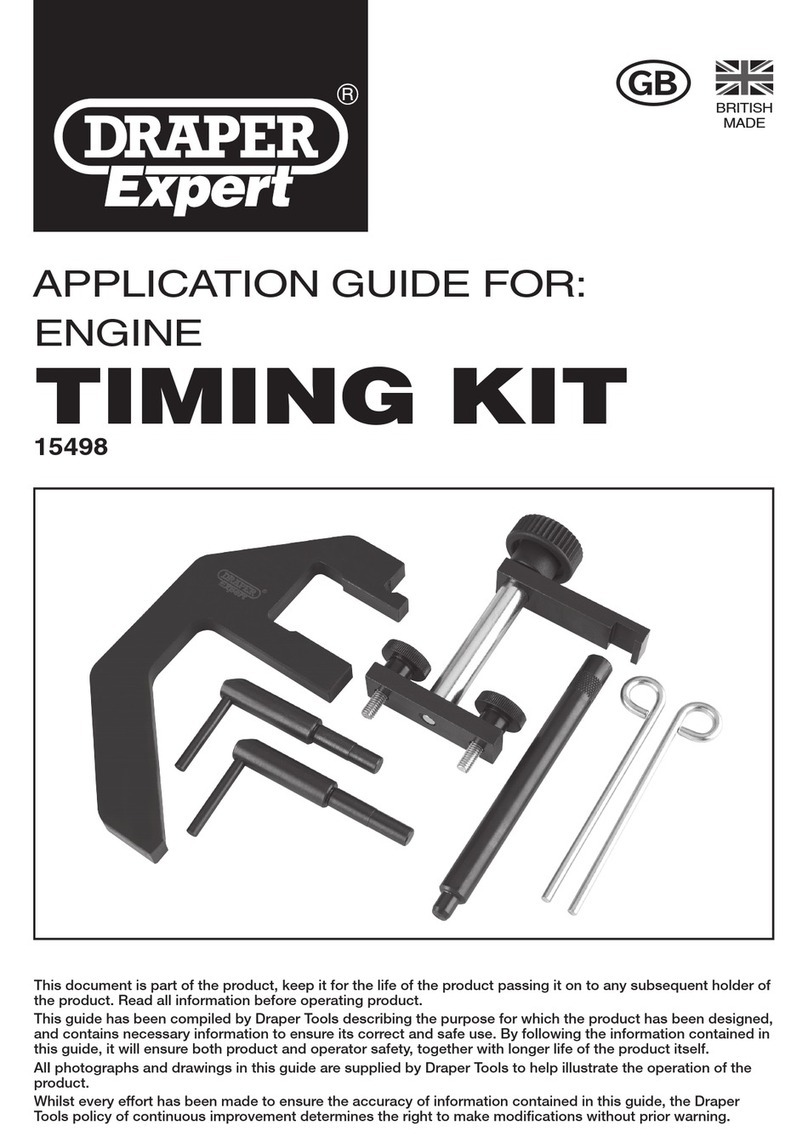
Draper
Draper 15498 User guide

Draper
Draper ALG33 User manual
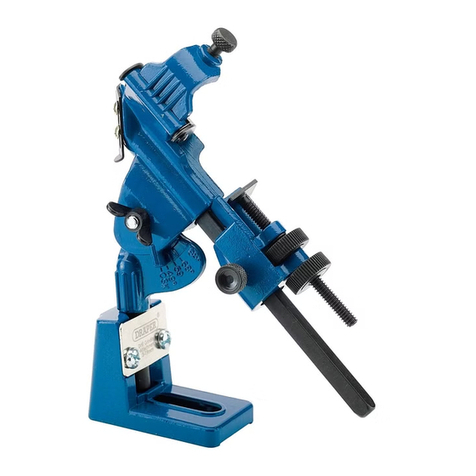
Draper
Draper 1180 User manual

Draper
Draper 23313 User manual
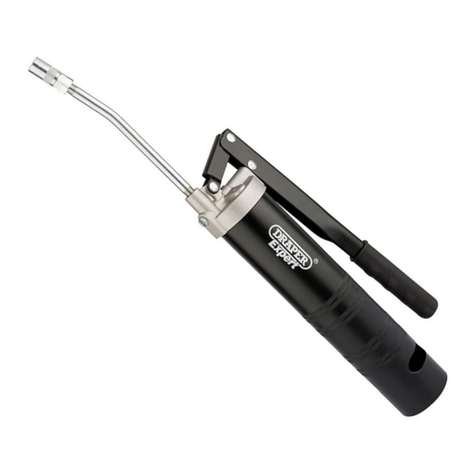
Draper
Draper A10/EXP/F User manual
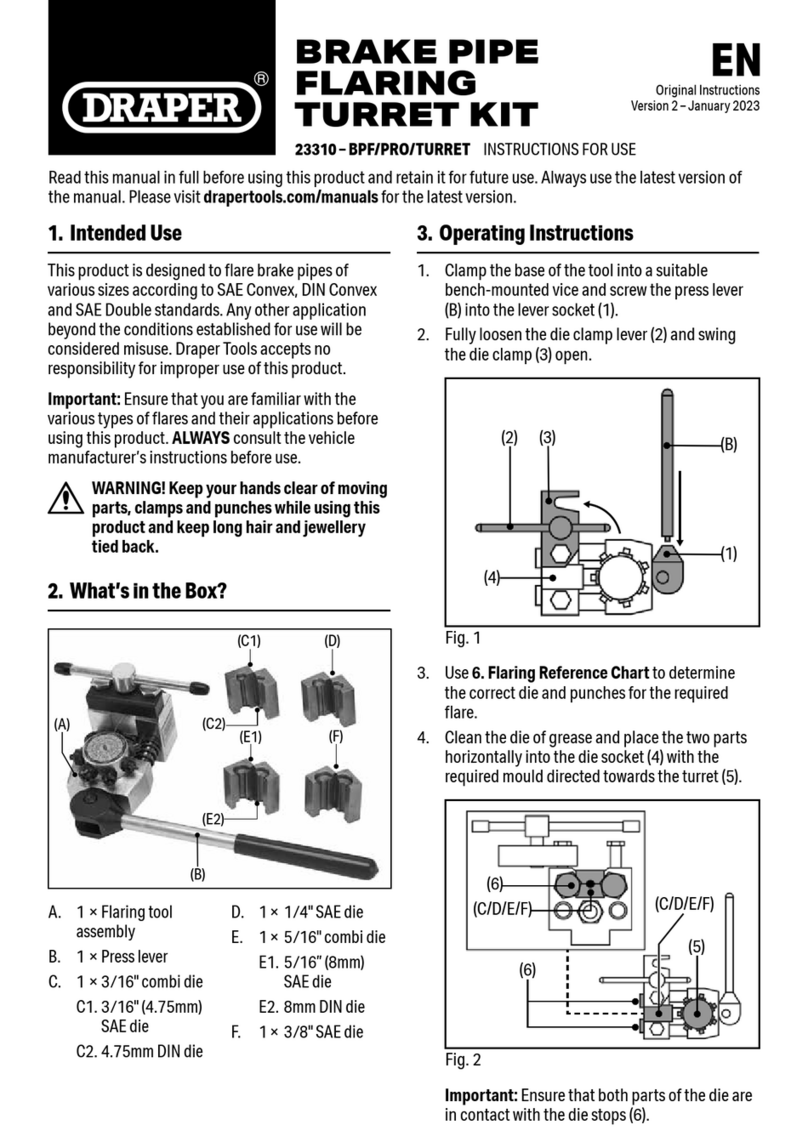
Draper
Draper 23310-BPF User manual
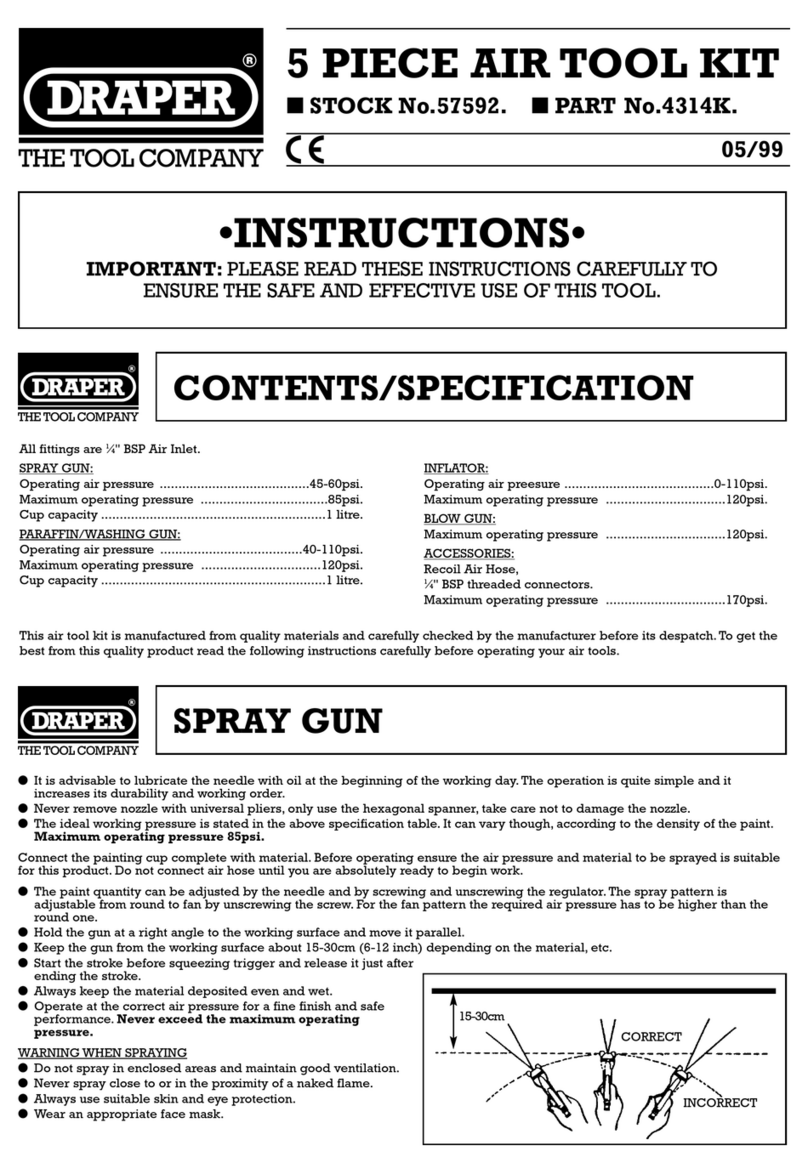
Draper
Draper 4314K User manual
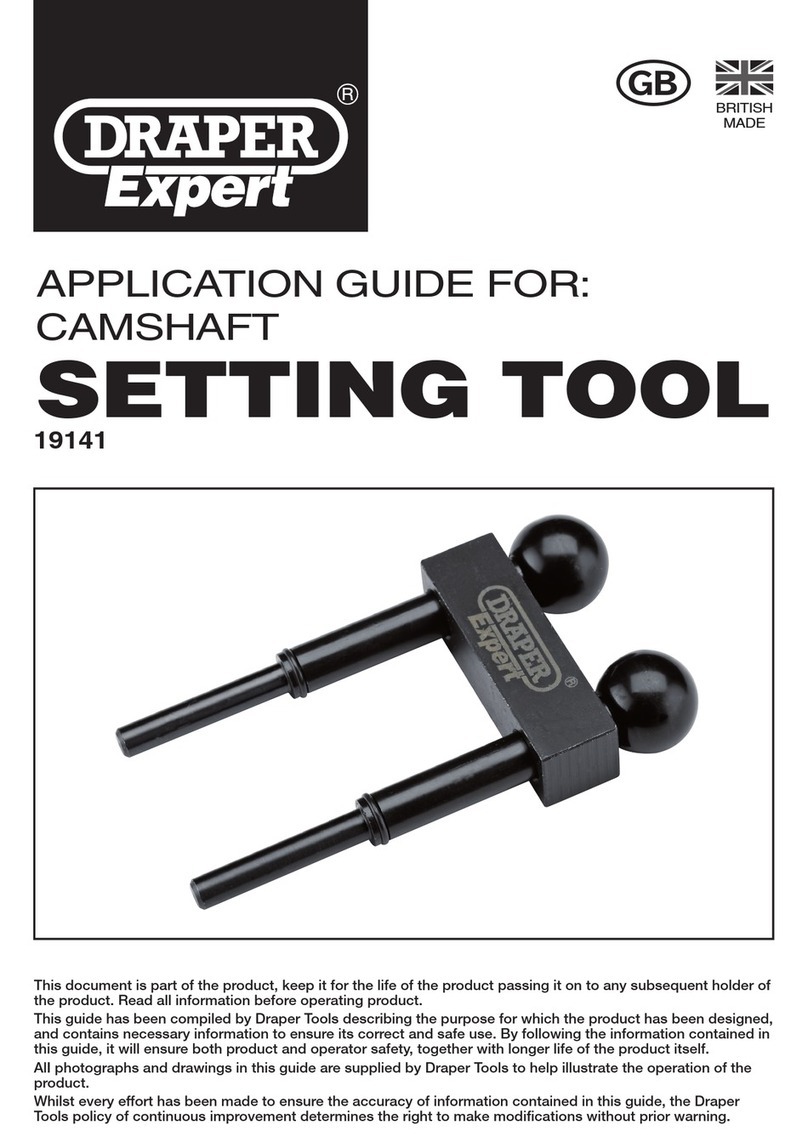
Draper
Draper 19141 User guide
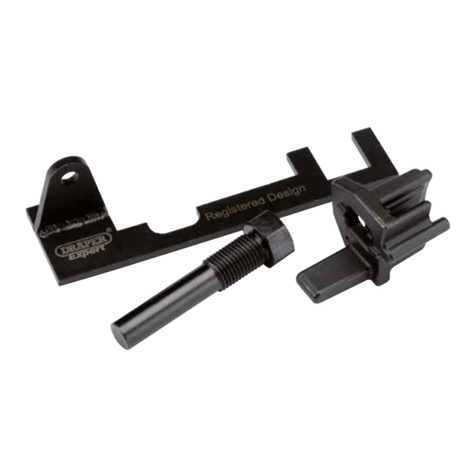
Draper
Draper Expert 19106 User guide

Draper
Draper 50094 User manual

Draper
Draper 18745 User guide
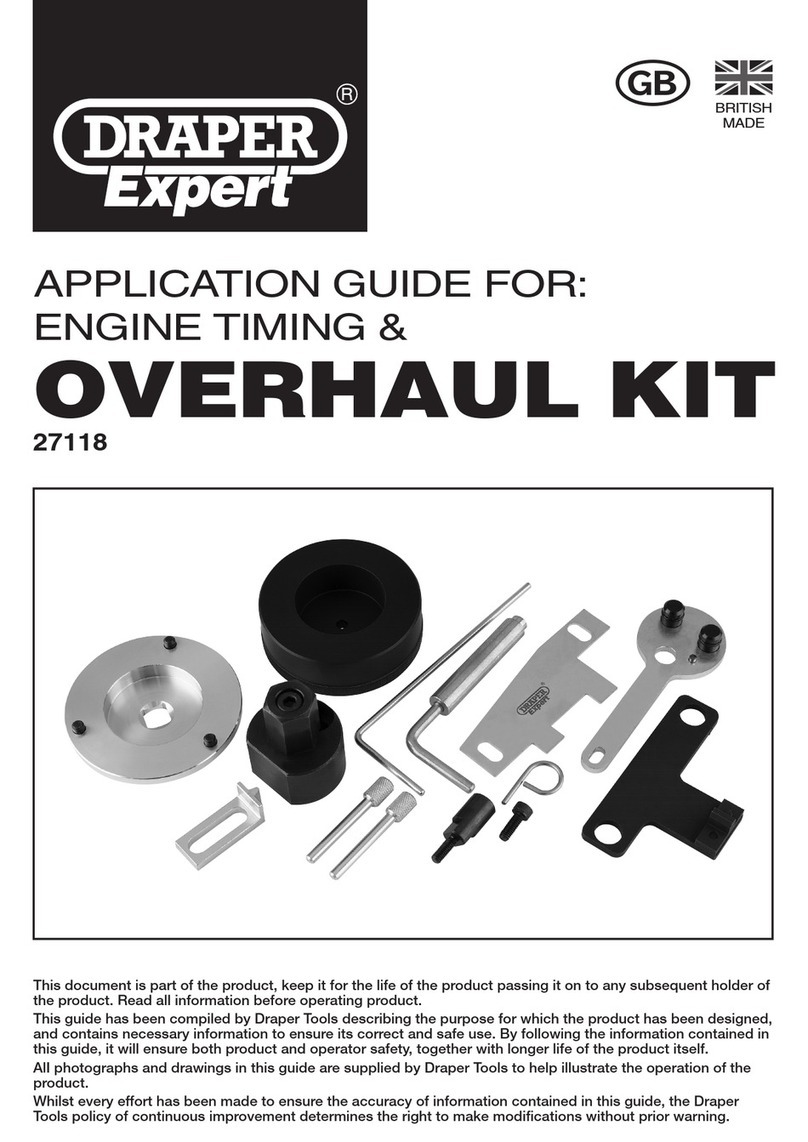
Draper
Draper 27118 User guide
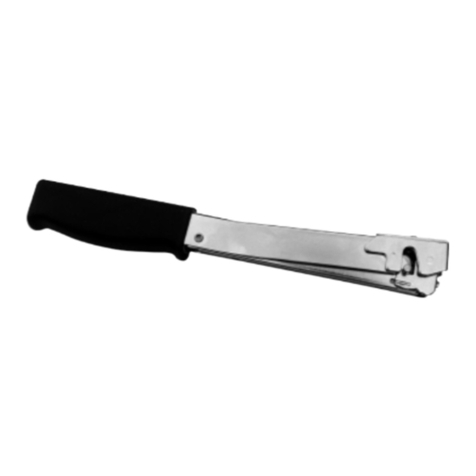
Draper
Draper HT/1 User manual

Draper
Draper STORMFORCE MT400 User manual
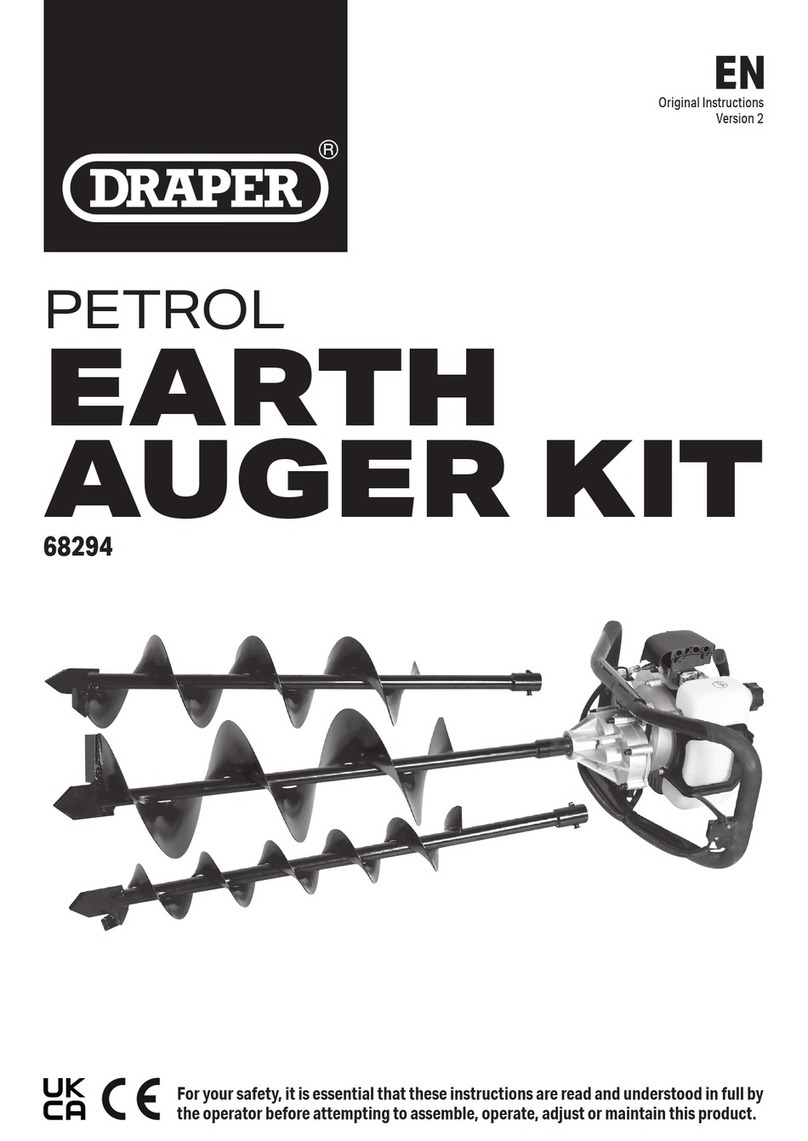
Draper
Draper GPAUG52-B User manual

Draper
Draper 18495 User guide
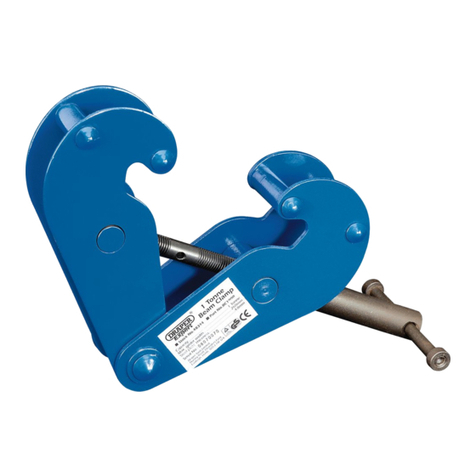
Draper
Draper BC1000 User manual
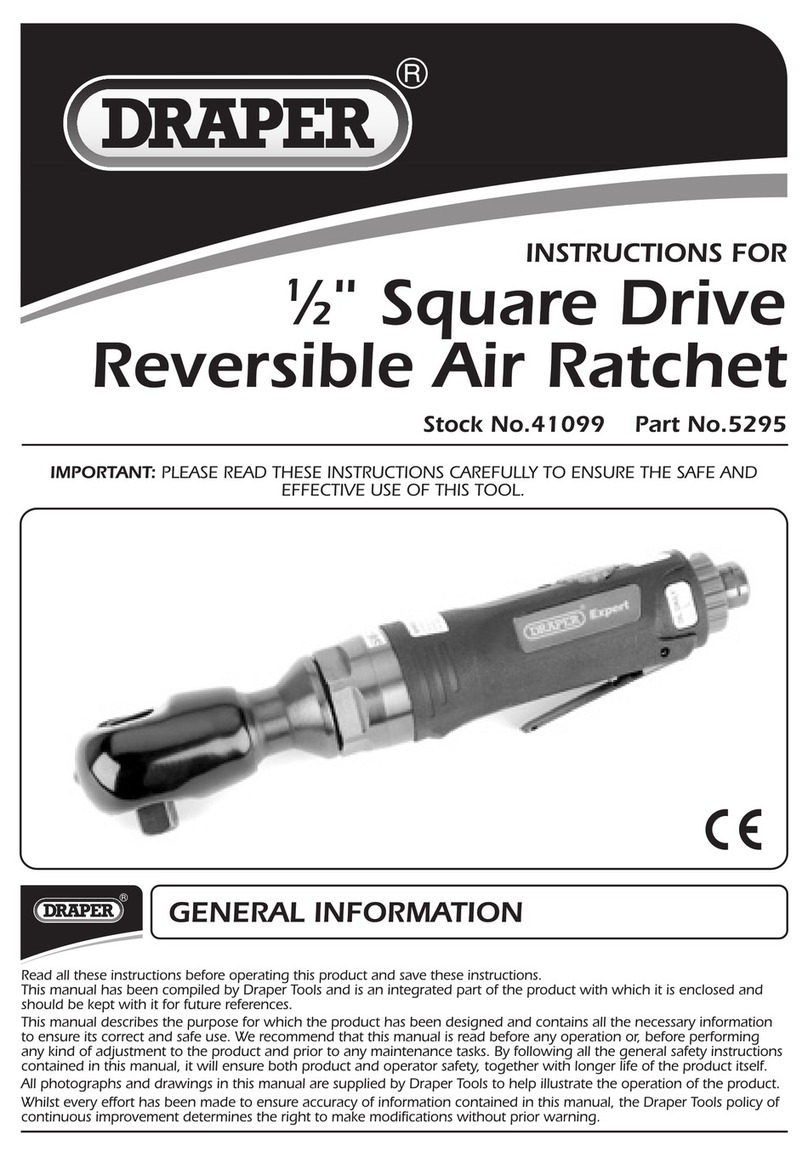
Draper
Draper 5295 User manual
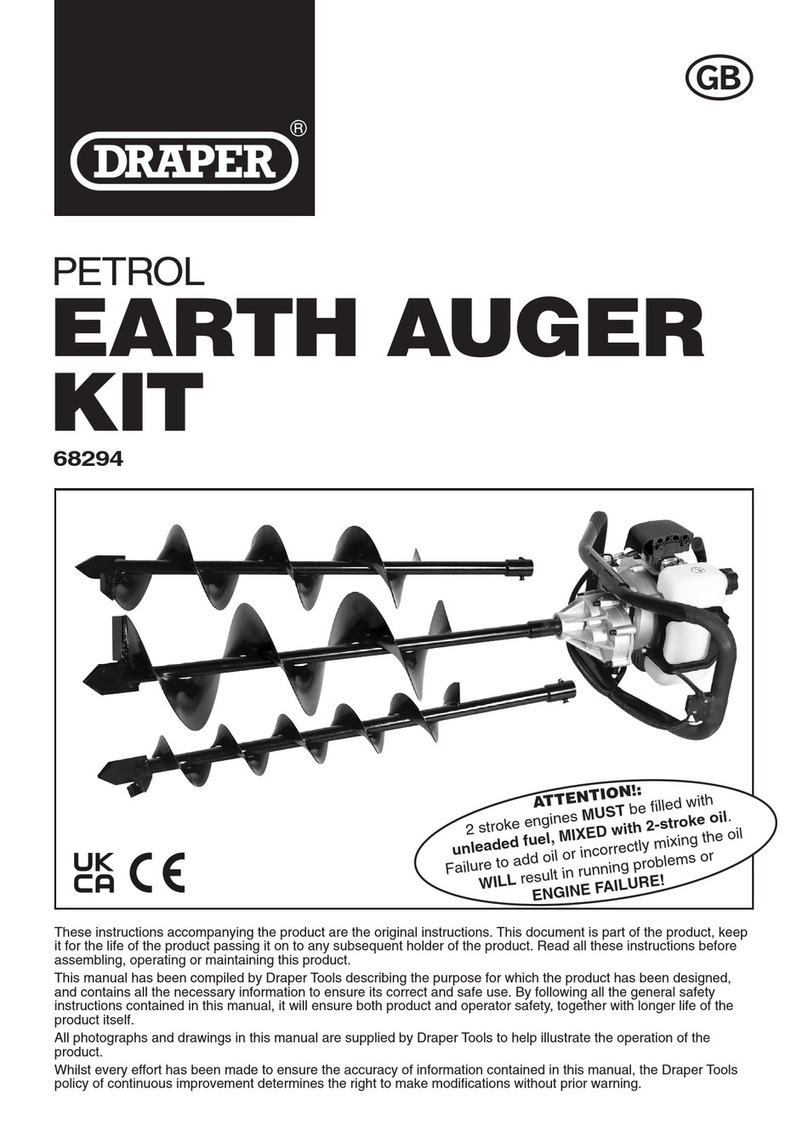
Draper
Draper GPAUG52-B User manual
